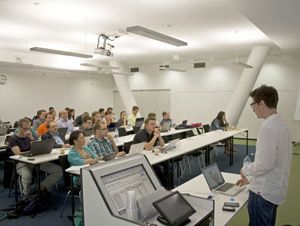"My name's Nicolas Kayser-Bril and I'm a nerd." With this statement the 26-year old Nicolas Kayser-Bril welcomes every visitor of his Blog nkb.fr. And yes, most probably he's a nerd: An interactive chart gives you information of his activity in social media and the number of incoming e-mails - 119 on monday. When the number is below 200, Kayser-Bril promises a fast answer. And, of course, it comes with an API.
Kayser-Bril spoke last week in Vienna at the DDJ-Conference organised by the FJUM Vienna and the European Journalism Center. DDJ stands for "data-driven journalism" and Kayser-Bril is one of the European pioneers in this new field of journalism.
(The German version of this article is available here.)
derStandard.at: There was a lot of buzz about big DDJ-projects made by the New York Times or the Guardian. How do you think small newsrooms can do good work with data without looking awkward beneath the NYT or the Guardian?
Nicolas Kayser-Bril: DDJ isn't only about big-scale projects, as the Guardian, ProPublica and NYT do. In any case, their DDJ operations are far from profitable, so they might not be a very good example to follow for smaller newsrooms. Other media outlets in the US set up DDJ teams with just 2 or 3 people (WNYC, LA Times ...) and create interesting products. Most importantly though, DDJ projects can be created by a single journalist, using free and easy-to-learn tools. In my opinion, the most important thing for a news organization is to have people in-house who know which tools to use and who know in which situations resources have to be invested to take on additional skills (developer, designer etc.) on a freelance basis.
derStandard.at: What skills do journalists need in the digital age which weren't a necessarity in the age of print?
Kayser-Bril: The need to adapt and learn quickly and continuously. Journalists moved from a playing field where they were monopolists to a new world where competition is rife - and where they don't have much of a competitive advantage. To create compelling content online, it's best to keep up-to-date as to which tools are best liked by users and which can help them improve productivity.
derStandard.at: Do journalists have to learn coding?
Kayser-Bril: No. The journalist-developer-statistician-designer is a dream for shareholders. No one can be good at all this. While coding skills are not needed, it's imperative that journalists know the basics of code, just as a TV journalist would know the basics of how a camera works, even though she always have a camera-person at hand.
derStandard.at: Which programming-language do you recommend for a noob who wants to visualize content?
Kayser-Bril: Javascript. JS is the language used in the browser. Most datavis are rendered using JS and it's fairly straightforward to tinker with the code to personalize them. The second language to learn should be server-side, like Python or PHP.
derStandard.at: On which projects do you work at the moment, which ones are upcoming?
Kayser-Bril: After months of trial and (lots of) errors, we redesigned our company, Journalism++, as an "incubator" for DDJ projects. We help clients make their ideas reality through consulting, training and development missions and develop our own ideas. One of these is Feowl, financed by the International Press Institute. It's an open-source platform that will be used in Cameroon to measure power cuts via SMS. (flog, derStandard.at, 19.06.2012)

